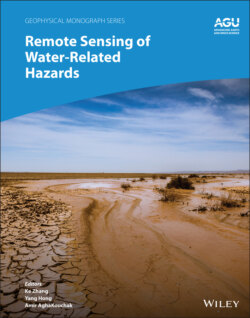Читать книгу Remote Sensing of Water-Related Hazards - Группа авторов - Страница 16
Part I: Remote Sensing of Precipitation and Storms
ОглавлениеPrecipitation is a key variable in global water and energy cycles, and a driver of many types of extreme events. Understanding the underlying mechanisms triggering water‐related natural hazards and monitoring and predicting these hazards require accurate precipitation data. Remote sensing of precipitation provides a valuable source of quasi‐global and near real‐time information, widely used in hydrometeorological studies and hazard monitoring. In chapter 2, Tang et al. summarize recent progress in global satellite remote sensing of precipitation and then focus on assessing the accuracy of the retrospective Integrated Multi‐satellite Retrievals for Global Precipitation Measurement (IMERG). Comparing IMERG with the other mainstream satellite and reanalysis products, they discuss advantages and disadvantages of IMERG relative to the other products. This chapter provides a valuable reference for both users and developers who are interested in practical applications, model development (bias correction and uncertainty assessment), and algorithm development of satellite precipitation products.
Figure 1.1 Structure and organization of this book.
Tornadoes, usually born during thunderstorms and accompanied by hail and/or heavy rainfall, are vertical funnels of rapidly spinning air and driven by extreme gradients in atmospheric pressure and temperature. Ground‐based, mobile Doppler radar is one of the most effective and reliable tools for observing and monitoring tornadoes. In chapter 3, Bluestein starts with a brief history of the different types of mobile radars and their properties (e.g., wavelength, type of modulation, and polarization technique). The chapter then describes how to determine (a) the distribution of wind in tornadoes and their parent storms, (b) the development of pretornado vortex signature, and (c) the tornadic vortex signature itself using ground‐based, mobile Doppler radars. Finally, this chapter discusses the potential new radar techniques for ground‐based mobile radars to improve the ability to probe tornadoes.
